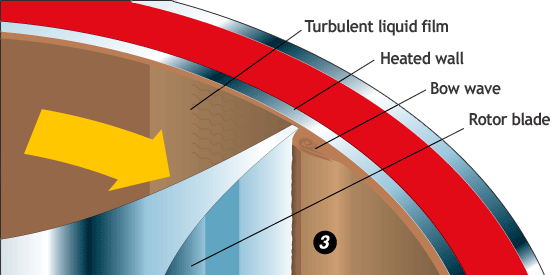
The LCI agitated thin film evaporator (also commonly referred to as a "wiped film evaporator") consists of two major assemblies: a cylindrical heated body and a rotor.
Product is introduced above the heated zone and is evenly distributed over the evaporator's inner surface by the rotor. As the product spirals down the wall, the high rotor tip speed generates highly turbulent flow resulting in the formation of bow waves (see illustration above) and creating optimum heat flux and mass transfer conditions.
Volatile components are rapidly evaporated via conductive heat transfer. Vapors flow either counter-currently or co-currently through the unit, depending on the application requirements. In both cases, vapors are ready for condensing or subsequent processing (i.e. fractionation) after exiting the vapor discharge section.
Nonvolatile components are discharged at the outlet. Continuous agitation and mixing by the rotor blades minimizes fouling of the thermal wall where the product or residue is most concentrated.
Thin Film Evaporation combines the following to handle heat-sensitive, viscous, and fouling processes:
Legend

